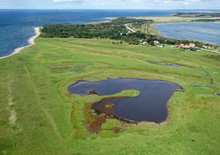
| Green-energy tour 2023 Kite aerial photography James S. and Susan E.W. Aber |
| Introduction | Northwest Denmark |
| Ramme Dige | Oddesund Nord |
| Southeast Denmark | Ristinge Klint |
| Nørre Frenderup | Bornholm |
| Dueodde | References |

| Green-energy tour 2023 Kite aerial photography James S. and Susan E.W. Aber |
| Introduction | Northwest Denmark |
| Ramme Dige | Oddesund Nord |
| Southeast Denmark | Ristinge Klint |
| Nørre Frenderup | Bornholm |
| Dueodde | References |
Denmark is a kite-friendly country and one of our favorite places to visit. We have, in fact, conducted kite aerial photography (KAP) in Denmark twice before—see 2005 and 2013. For these earlier visits we had exceptionally nice weather, but the late summer and early autumn of 2023 were relatively cool with cloudy sky and frequent rain. This limited our KAP opportunities. Nonetheless, we had good success at five sites—two each in the northwestern mainland and the southern islands, as well as one site on the island of Bornholm to the east.
This was our third time to conduct kite aerial photography at Ramme Dige, so clearly this is our favorite place in Denmark for KAP. Also of interest here are nearby wind turbines and a new solar farm.
The Ramme wind farm has experienced significant changes since we first visited in 2005. It currently has 12 operational Vestas turbines—six have capacities of 2.0 megawatts (MW), and six are 3.3 MW each for a total of 31.8 MW electric-generating capacity. These are large modern turbines. However, 21 older and smaller turbines were dismantled during the period 2002 to 2014—see Ramme. This demonstrates the results of governmental incentives to replace many smaller, older turbines with fewer, larger turbines.
Northwestern Denmark
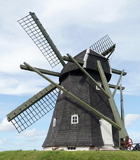
Kloster Mølle
Vestervig
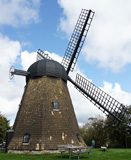
Refsbøl Mølle
Hurup
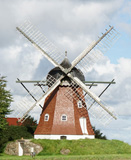
Heltborg Mølle
near Hurup
Ramme Dige
Ramme Dige is a well-known site for archaeologic remains located in western Denmark near the North Sea coast. It includes a cluster of burial mounds dating from the Neolithic (New Stone Age) and Bronze Age, as well as a wall-ditch structure (dige) that extends more than 2.5 km (~1½ miles) long. The wall and ditch were built during the middle Iron Age, presumably A.D. 200-400 interval. Many more burial mounds once existed, but several have been removed over the years.Oddesund Nord
Oddesund is a narrow finger of land that separates Nissum Bay from the Limfjord in northwestern Denmark. A narrow gap allows water flow and ships to pass, and the gap is bridged for railroad, highway, bicycle, and pedestrian traffic. An observation tower provides good views and historical information about the area.
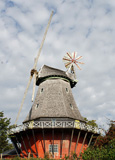 Lindelse Mølle Langeland 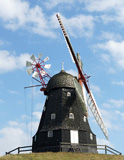 Skovsgaard Mølle Langeland 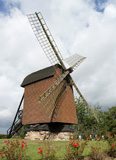 Østofte Stubmølle Lolland |
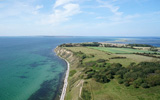
Overview (left) and closer shot (right) of Ristinge Klint looking toward the west. The cliff face is mostly covered by vegetation, so the geological strata are not readily visible.
| 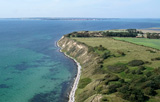 
View toward east (left). The building on the left is a former resort hotel built originally in 1926 and expanded in the 1950s and 1960s. This structure will be replaced soon, as approved and revised—see Ristinge Strandhotel. Kite flyers at lower center. Sun glint on water (right) highlights wave patterns.
| 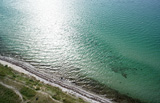
|
Like the rest of Denmark, Bornholm has a large variety and long history of windmills. Bornholm today is developing into an energy island that will become the hub for electricity generated by wind turbines in the surrounding sea. This electricity will be sent to the rest of Denmark and exported to Germany via high-voltage undersea cables—see Energy Island Bornholm.
 Egeby Stubmølle Built 1787 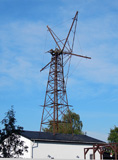 Agricco framework Østerlars, ~1920  Kuremøllen Built 1861 |
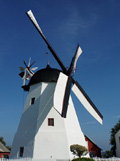
Aarsdale Mølle is a fully functional Dutch-style mill with flap blades and fantail that dates from 1877. Flaps closed (left) and open (right); note shadow on mill side. The blades rotate counterclockwise when flaps are closed and stop turning with open flaps. Originally equiped with canvas-sail blades, these were replaced by flap blades beginning in 1919, and the fantail was added. Flap blades are much easier to control. See Årsdale Mill.
| 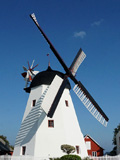 
Detail of flap blade (left) with flaps in closed position. Note curvature of the blade. Interior wooden gears (right). Large gear on left drives smaller gears on right that turn mill stones.
| 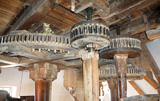
|
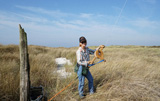
| 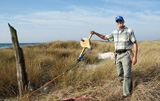
|
![]()
![]() Return to KAP gallery or KAP home.
Return to KAP gallery or KAP home.
Last update: October 2023.